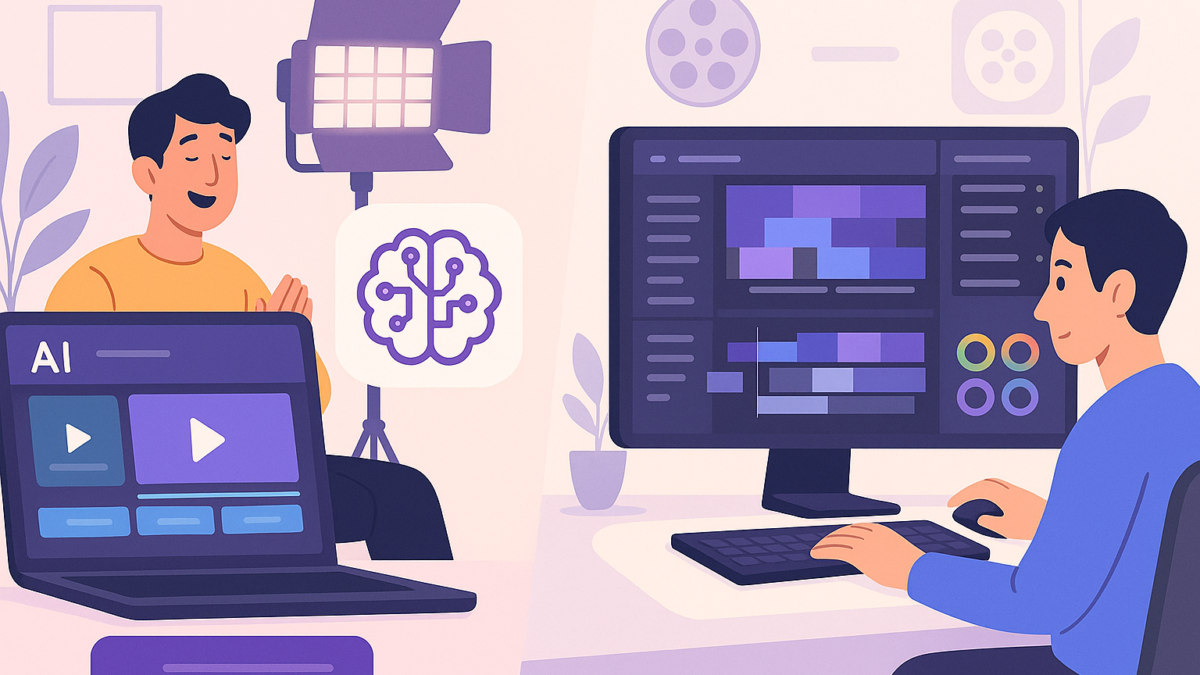AI Video Editors vs Traditional Tools: Which Boosts: Productivity in 2025?
Table of Contents
Introduction
In 2025, content creation is more fast-paced, competitive, and crucial than ever before. Video, in particular, is dominating digital communication across platforms like YouTube, TikTok, and LinkedIn. With this boom comes the need for efficient video editing — and that’s where AI tools have started to challenge traditional editors.
But which type of video editing software actually enhances productivity in today’s creative workflows? Should creators, marketers, and businesses switch to AI-powered editors, or stick with industry-standard tools like Adobe Premiere Pro and Final Cut Pro?
Let’s break down the pros, cons, and real-world use cases of AI video editors vs traditional video editors to find out which is best for productivity in 2025.
What Are AI Video Editors?
AI video editors are platforms that use machine learning and automation to simplify or eliminate complex editing tasks. These tools analyze footage, audio, and even user intent to auto-generate or assist in creating polished videos.
Key Features of AI Video Editors:
- Auto-editing based on beats, motion, or templates
- Text-to-video generation using scripts or prompts
- Background removal & scene detection
- AI voiceovers and subtitles
- Facial recognition and smart cropping
- Instant social media optimization
Popular AI Editors in 2025:
- Runway ML
- Pictory
- Descript
- Magisto
- Adobe Sensei-powered tools
What Are Traditional Video Editors?
Traditional editors offer full creative control with manual workflows. These include tools like:
- Adobe Premiere Pro
- Final Cut Pro
- DaVinci Resolve
- Sony Vegas Pro
They’re widely used in filmmaking, broadcasting, and professional content creation. These tools often require experience and time, but they offer unmatched precision.
AI Video Editors: How They Boost Productivity
AI editors are game changers when speed, scale, and ease are top priorities. Here’s how they outperform traditional tools in certain contexts:
- Faster Turnaround Times: AI tools can automate tedious processes like trimming silences, syncing with music, or resizing videos for different platforms. For social media marketers and content creators, this means publishing more content with less effort.
- Example: A 5-minute promotional video that takes 3-4 hours on Adobe Premiere can be done in 30 minutes using Pictory.
- Accessibility for Non-Editors: With drag-and-drop interfaces and automated workflows, even marketers, sales teams, or educators with no video experience can produce engaging content.
- Lower Production Costs: Businesses can reduce dependency on expensive editors for basic video needs like testimonials, explainers, and training videos.
- AI-Enhanced Creativity: Tools like Runway’s Gen-2 can generate entirely new video clips from text prompts — opening new possibilities in storytelling, especially for brands and creators experimenting with formats.
Traditional Video Editors: Why They Still Matter
While AI shines in speed and accessibility, traditional tools remain essential for high-end production and creative control.
- Precision & Customization: AI can miss creative nuances. For example, a filmmaker might want specific cuts or transitions that AI can’t replicate. Traditional editors allow granular control over every frame.
- Complex Projects & Effects: Projects involving multi-layer timelines, VFX, color grading, or 3D rendering require the advanced capabilities of professional editors.
- Professional Industry Standards: Film studios, ad agencies, and broadcast companies still rely on traditional editors to meet specific quality and format standards.
AI vs Traditional Editors: Side-by-Side Comparison
| Feature | AI Video Editors | Traditional Editors |
|---|---|---|
| Learning Curve | Very Low | Moderate to High |
| Editing Speed | Very Fast (Automated) | Slower (Manual Workflows) |
| Creative Flexibility | Limited | Very High |
| Use Case Fit | Short-form, social, business videos | Film, ads, branded content |
| Cost of Entry | Lower | Higher (licenses, hardware) |
| Team Collaboration | Cloud-based & intuitive | Plugin-dependent |
| Output Quality | Good (template-based) | Excellent (fully customized) |
Real-World Use Cases in 2025
- Marketing Teams: AI editors help repurpose webinars, blogs, and podcast snippets into short-form videos in minutes — enhancing content ROI and reach.
- Educators & Coaches: With auto-captioning and voiceover generation, AI tools enable fast content delivery and accessibility without technical help.
- Agencies & Filmmakers: While AI speeds up basic editing, professionals often start with AI for rough cuts and finish in traditional tools for finesse.
Which Enhances Productivity More in 2025?
It depends on who you are and what you need.
- For solo creators, educators, and marketers, AI video editors can multiply output, reduce costs, and simplify workflows — making them the top choice for productivity in 2025.
- For filmmakers, creative agencies, and video professionals, traditional editors still offer the depth and control necessary for premium content creation.
- Hybrid workflows are also emerging — creators start with AI for rough edits or ideation, then polish using traditional software.
Final Verdict: Productivity Comes Down to Purpose
The future of video editing isn’t about choosing one over the other — it’s about integrating the right tools for the right tasks.
✅ Want to create a quick ad, testimonial, or explainer video?
Go AI.
🎯 Need full control over branding, pacing, and visuals?
Go traditional — or use AI to accelerate the first draft.
Ready to Scale Your Video Creation Strategy?
Whether you’re a startup marketer or a seasoned editor, the key is to build a workflow that saves time without compromising quality.
👉 Explore the best AI video editors and boost your 2025 productivity today.
You May Also Like: What Is Google Cloud & How It Helps Businesses Grow





